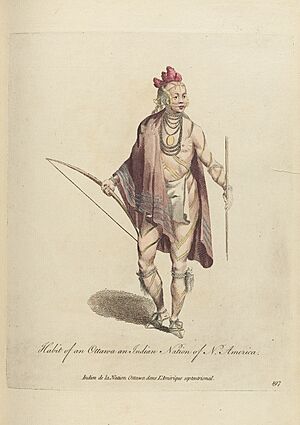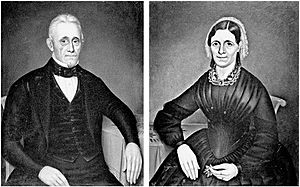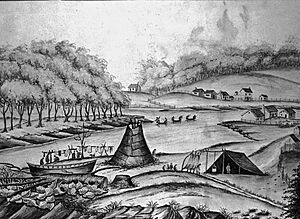Louis Campau facts for kids
Quick facts for kids
Louis Campau
|
|
|---|---|
 |
|
| Born | August 11, 1791 |
| Died | April 13, 1871 |
Louis Campau (born August 11, 1791 – died April 13, 1871), sometimes spelled Louis Campeau, was a very important person in the early days of Michigan. He helped start two big cities: Saginaw and Grand Rapids. He set up trading posts in both places. Louis Campau also helped with talks between the local Native American tribes and the United States government. One important agreement he was involved in was the Treaty of Detroit in 1855. A local chief named Cobmoosa signed this treaty.
Contents
Who Was Louis Campau?
His Early Life and Family
Louis Campau was born in 1791 in Detroit, Michigan. His family, the Campau family, was well-known and had French roots. From a young age, Louis worked in the fur trade with his father, Louis Campau, Sr., and his uncle, Joseph Campau. During the War of 1812, he served in the United States Army.
His wife was Sophie Marsac, who was also born in Detroit. Sophie's family was an early and notable family from New France. A group called the Sophie de Marsac Campau Grand Rapids Chapter of the Daughters of the American Revolution was named after her. They wanted to remember her as a "woman of rare grace and character" who was highly respected by the early settlers.
Starting a Trading Post in Saginaw

Louis Campau set up the very first trading post in what is now Saginaw, Michigan, as early as 1815. He played a big part in working out the Treaty of Saginaw in 1819. This treaty was an agreement between General Lewis Cass and Native American tribes from the Great Lakes region. These tribes were mainly the Ojibwe, but also the Odawa (Ottawa) and Potawatomi tribes of Michigan. Through this treaty, Native Americans gave up more than six million acres (24,000 km²) of land in the central part of Michigan.
Founding Grand Rapids
After a Baptist minister named Isaac McCoy started a mission in the area, Louis Campau arrived in what would become Grand Rapids, Michigan. He came because another fur trader suggested it. Campau soon became known as the official founder of Grand Rapids.
In 1826, Campau built his cabin, trading post, and a blacksmith shop. He built them on the east side of the Grand River, near the rapids. He found that the local Native Americans were "friendly and peaceable." Campau went to Detroit and came back a year later with his wife. He also brought $5,000 worth of goods to trade with the Odawa and Ojibwa tribes for furs. His younger brother, Touissant, often helped him with his business.
In 1831, the government surveyed the Northwest Territory and offered land for sale. Campau bought 72 acres around his trading post and near the Baptist mission. He paid $90 for it on September 19, 1831. His wife and several family members lived at the post. Some of his brothers and nephews also moved to Grand Rapids. One year later, a government surveyor named Lucius Lyon bought land north of Campau's property.
Campau mapped out his village following old Native American trails. Lyon, however, mapped his property using an English grid system. This meant there were two villages right next to each other, but with different street layouts. Campau's village had a row of 16 houses on Pearl Street that bordered Lyon's village. This made it hard to travel between the two villages. People had to go north to Division Street to cross into Campau's village.
Campau, who was known for being short-tempered, and Lyon also disagreed about the town's name. Lyon wanted to call it the village of Kent, not Grand Rapids. Lyon and some land investors from New York had formed the Kent Company. This company was named after a judge in New York, James Kent. They were interested in developing land along the Grand River.
Even though Lyon bought land near the river and created Canal Street to connect with Campau's Monroe Avenue, the Kent Company eventually "went out of business." Campau then combined the two villages under the name Grand Rapids. It officially became a town in 1838 and a city in 1850.
Campau was also good friends with William Quevillon. William was the first white settler in Ludington, Michigan.
In October 1883, Louis Campau was the first settler in Kent County, Michigan to buy land from the White Pigeon land office. This office was located on the Chicago Road (Sauk Trail), which connected Chicago and Detroit.
His Role in Indian Treaties
Both Louis and his brother Antoine were involved in treaty negotiations. These negotiations brought them a lot of money. Louis was involved in the Treaty of Detroit in 1855 and received a large payment for his part in the talks. This treaty with the federal government meant that one of the signers, Chief Cobmoosa, would move with his tribe from the Grand Rapids area to Oceana County, Michigan.
The treaty was signed in Detroit by 54 other leaders from Odawa and Chippewa tribes. In exchange for their traditional lands, about $540,000 in cash and goods was divided among all the tribes. A lot of this money went to "white friends," like Campau. The chiefs received $500, and headmen received $100. These payments were planned to be paid out over 10 years.





